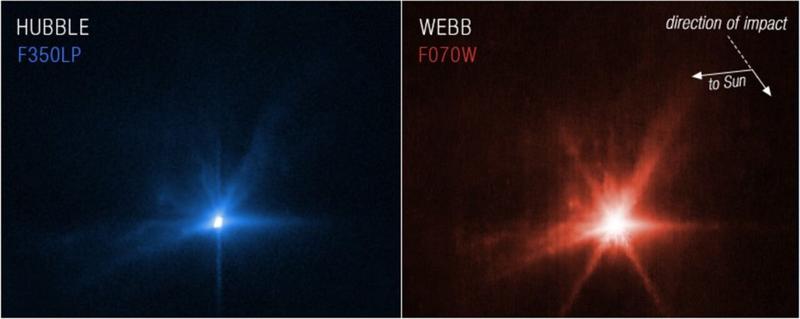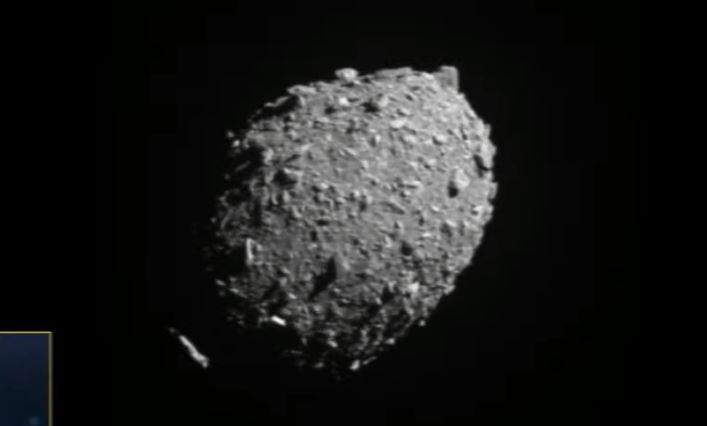
The U.S. space agency successfully deflected an asteroid from its path by crashing a spacecraft into its surface in late September in a first-of-its-kind test mission that will help humanity learn to defend itself against a possible future threat, NASA announced. on Tuesday, according to AFP.
The Dart mission’s spacecraft intentionally hit its target, the asteroid Dimorphos, which is a satellite of a larger asteroid called Didymos.
The NASA spacecraft was able to move the asteroid, shortening its orbit by 32 minutes, the head of the space agency, Bill Nelson, said at a press conference.
This is “a watershed moment for protecting the planet and a watershed moment for humanity,” he said.
It would already “be considered a huge success if (the spacecraft) shortened the orbit by only 10 minutes. But in fact, he shortened it by 32 minutes,” he added. With this mission, NASA has proven that it is serious about protecting the planet,” he said.

Collision between DART and Dimorphos seen by Webb and Hubble. Photo: European Space Agency
Dimorphos, located at the time of the collision about 11 million kilometers from Earth, has a diameter of about 160 meters and does not pose a danger to our planet.
Although the goal is relatively modest compared to disaster scenarios in sci-fi movies like Armageddon, this unprecedented “planet defense” mission called Dart is the first to test such a technique.
This allows NASA to train in case an asteroid threatens to collide with Earth.
The spacecraft was about 100 times smaller than Dimorphos, so it did not destroy the asteroid. The mission team compared the impact to a golf cart crashing into one of the Great Pyramids, generating enough energy to leave a crater.
- Read also: How the Webb and Hubble telescopes captured the collision of the DART probe with the asteroid Dimorphos

A few minutes after the impact (photo: NASA TV)
What’s next
Ground-based observatories around the world will observe the asteroid system to confirm whether DART has succeeded in altering the asteroid’s motion.
The James Webb Space Telescope, the Hubble Space Telescope and NASA’s Lucy mission will also observe the aftermath.
Additionally, the European Space Agency’s Hera mission will launch in 2024 to continue studying the impact.
The spacecraft, along with two CubeSats, will arrive at the asteroid system in two years.
Hera will explore both asteroids, measure the physical properties of Dimorphos, study the impact crater and the orbit of the Moon in order to create an effective strategy for protecting the planet.
Asteroids and Earth – a story with fears, but also groundless exaggerations
We know that there are 26,000 asteroids that regularly approach Earth’s orbit, and the most famous ones that humanity has been able to visit are Bennu and Ryuga.
Researchers have come up with many ways to dispose of an asteroid that will become dangerous for Earth. Among the scenarios considered were: destruction by nuclear warheads, “burning” of the asteroid by lasers, or a change in trajectory after the asteroid “hooked” an approaching shuttle. Other options were considered, but all of them are too complicated for modern technologies.
Asteroids are the remnants of planetesimals, or small planets, from the early days of the Solar System, 4.5 billion years ago. They were supposed to form a planet, but Jupiter’s strong gravity prevented them. Asteroids are very useful in space exploration because they are assumed to have remained unchanged since the formation of the solar system, and if we study them, we can learn important things about the formation of space.
There are often exaggerated reports in the news that an asteroid may soon hit Earth and wreak havoc, but the truth is that there is no record of anything like that happening this century.
For example, the dreaded Apophis, an asteroid named after the Egyptian god of evil and destruction, will not pose any danger of hitting Earth for at least 100 years, NASA and the European Space Agency announced in 2021, which also removed it from the asteroid risk list. , which may collide with our planet.
Link:
- INTERVIEW Romanians contribute to asteroid deflection / Their role in ESA’s first planet defense mission
Source: Hot News RO
Robert is an experienced journalist who has been covering the automobile industry for over a decade. He has a deep understanding of the latest technologies and trends in the industry and is known for his thorough and in-depth reporting.